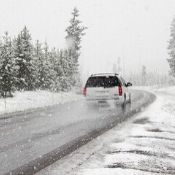| Keep your crew safe on the road this winter |
 |
| Written by Troy Sibelius |
| Monday, November 25, 2019 02:00 AM |
|
General Winter Driving Tips A safe stop on icy or snow-packed roads is a tricky maneuver that requires skill and good judgment. Anticipate stops by slowing down gradually, well ahead of intersections. And allow more than enough time to stop safely. Plan ahead for lane changes; check your rearview mirror, your blind spots and signal your intentions to traffic behind you. Then, swing over in a long, gradual line. Make the move with the smallest possible steering change and with a light foot on the gas. When driving in deep snow, stepping on the gas may cause the wheels to spin, with little, if any, forward movement. In such cases, avoid over-accelerating. A light foot on the gas pedal and a high gear is most effective. Winter Driving – Skids One of the most dangerous winter driving hazards is skidding. If it happens at a high speed, the result can be deadly. But most skids can be avoided by simply adjusting to driving conditions and knowing how to recover from a skid. Skids are most likely to occur on curves and turns, so slow down ahead of time to prepare for them. Then, when in the curve, accelerate slowly and steer steadily with no abrupt change in direction and, especially, no abrupt braking. Driving smoothly in general can help prevent skids. Skid Safety Techniques
Instead, immediately take your foot off the accelerator and steer in the direction the vehicle is sliding until you feel recovery of traction, then slowly straighten the wheels until you recover complete control. If the back of your vehicle is fishtailing to the right, turn the wheel gently in that direction until your car recovers. If braking is necessary before traction is recovered, apply the brake pedal cautiously so you do not lock the wheels and intensify the skid. You will also have better brake control in a skid situation if your vehicle is equipped with anti-lock brakes. Constantly be on the lookout for areas that might induce skidding, such as unexpected ice patches or piles of wet leaves, which tend to be found in shady areas or on overpasses. Keep in mind that wet ice, warmed by the sun, is twice as dangerous as completely frozen ice. Be especially alert whenever there is any kind of precipitation during cold weather. —Troy D. Sibelius, FASLA, CIC, CRM, is an Executive Vice President and Client Advisor at The Buckner Company. He also has a Landscape Architecture degree from CSU and works extensively with landscape contractors and landscape architects on their risk management and commercial insurance programs. This story is an excerpt from an article that originally appeared in the November-December 2019 issue of Colorado Green magazine. Read more in this issue of Colorado Green NOW: |

 When bad weather hits, make sure you and your crew are prepared to navigate the snowy streets. Troy Sibelius of Buckner Company shares winter driving tips.
When bad weather hits, make sure you and your crew are prepared to navigate the snowy streets. Troy Sibelius of Buckner Company shares winter driving tips.
